Scott, Sir Walter
For other people named Walter Scott, see Walter Scott (disambiguation).
| Sir Walter Scott, 1st Baronet |
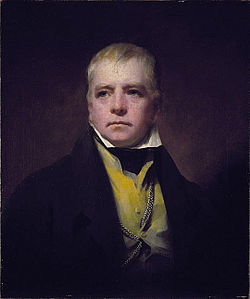
Raeburn's portrait of Sir Walter Scott in 1822 |
| Born |
15 August 1771
Edinburgh, Scotland |
| Died |
21 September 1832(1832-09-21) (aged 61)
Melrose, Scotland |
| Occupation |
Historical novelist, Poet, Lawyer, Sheriff of Selkirkshire |
| Nationality |
Scottish |
| Literary movement |
Romanticism |
| Spouse(s) |
Charlotte Carpenter (Charpentier) |
Influences
- Maria Edgeworth, Shakespeare, King James Bible, Edmund Spenser, John Dryden, Jonathan Swift, Henry Mackenzie, Thomas Blacklock
|
Influenced
- The Brontë Sisters, Elizabeth Gaskell, G.P.R. James, James Hogg, Honoré de Balzac, Victor Hugo, James Fenimore Cooper, Sheridan Le Fanu, Robert Louis Stevenson, George Eliot, Charles Dickens, John Banim, N. D. Wilson, Sir Arthur Conan Doyle
|
|
| Signature |
 |
Sir Walter Scott, 1st Baronet (15 August 1771 – 21 September 1832) was a Scottish historical novelist, playwright, and poet, popular throughout much of the world during his time.
Scott was the first English-language author to have a truly international career in his lifetime,[1] with many contemporary readers in Europe, Australia, and North America. His novels and poetry are still read, and many of his works remain classics of both English-language literature and of Scottish literature. Famous titles include Ivanhoe, Rob Roy, The Lady of the Lake, Waverley, The Heart of Midlothian and The Bride of Lammermoor.
[edit] Biography
[edit] Early days

Scott's childhood at Sandyknowes, in the shadow of Smailholm Tower, introduced him to the tales and folklore of the Scottish Borders.
Born in College Wynd[2] in the Old Town of Edinburgh in 1771, the son of a solicitor, Scott survived a childhood bout of polio in 1773 that left him lame.[3] To cure his lameness he was sent in 1773 to live in the rural Borders region at his paternal grandparents' farm at Sandyknowe, adjacent to the ruin of Smailholm Tower, the earlier family home.[4] Here he was taught to read by his aunt Jenny, and learned from her the speech patterns and many of the tales and legends that characterised much of his work. In January 1775 he returned to Edinburgh, and that summer went with his aunt Jenny to take spa treatment at Bath in England, where they lived at 6 South Parade.[5] In the winter of 1776 he went back to Sandyknowe, with another attempt at a water cure at Prestonpans during the following summer.[4]

Scott's home from the age of 4 to 26 in George Square, Edinburgh
In 1778 Scott returned to Edinburgh for private education to prepare him for school, and in October 1779 he began at the Royal High School of Edinburgh. He was now well able to walk and explore the city and the surrounding countryside. His reading included chivalric romances, poems, history and travel books. He was given private tuition by James Mitchell in arithmetic and writing, and learned from him the history of the Kirk with emphasis on the Covenanters. After finishing school he was sent to stay for six months with his aunt Jenny in Kelso, attending the local grammar school where he met James and John Ballantyne who later became his business partners and printed his books.[6]
[edit] Scott's meeting with Blacklock and Burns
Scott began studying classics at the University of Edinburgh in November 1783, at the age of only 12, a year or so younger than most of his fellow students. In March 1786 he began an apprenticeship in his father's office to become a Writer to the Signet. While at the university Scott had become a friend of Adam Ferguson, the son of Professor Adam Ferguson who hosted literary salons. Scott met the blind poet Thomas Blacklock who lent him books as well as introducing him to James Macpherson's Ossian cycle of poems. During the winter of 1786–87 the 15-year-old Scott saw Robert Burns at one of these salons, for what was to be their only meeting. When Burns noticed a print illustrating the poem "The Justice of the Peace" and asked who had written the poem, only Scott knew that it was by John Langhorne, and was thanked by Burns.[7] When it was decided that he would become a lawyer, he returned to the university to study law, first taking classes in Moral Philosophy and Universal History in 1789–90.[6]
After completing his studies in law, he became a lawyer in Edinburgh. As a lawyer's clerk he made his first visit to the Scottish Highlands directing an eviction. He was admitted to the Faculty of Advocates in 1792. He had an unsuccessful love suit with Williamina Belsches of Fettercairn, who married Scott´s friend Sir William Forbes, 6th Baronet.
[edit] Literary career launched

A copy of Scott's Minstrelsy in the National Museum of Scotland
As a boy, youth and young man, Scott was fascinated by the oral traditions of the Scottish Borders. He was an obsessive collector of stories, and developed an innovative method of recording what he heard at the feet of local story-tellers using carvings on twigs, to avoid the disapproval of those who believed that such stories were neither for writing down nor for printing. At the age of 25 he began to write professionally, translating works from German,[8] his first publication being rhymed versions of ballads by Gottfried August Bürger in 1796. He then published an idiosyncratic three-volume set of collected ballads of his adopted home region, The Minstrelsy of the Scottish Border. This was the first sign from a literary standpoint of his interest in Scottish history.
As a result of his early polio infection, Scott had a pronounced limp. Although a determined walker, on horseback he experienced greater freedom of movement. Unable to consider a military career, Scott enlisted as a volunteer in the 1st Lothian and Border yeomanry.[9] On a trip to the Lake District with old college friends he met Charlotte Genevieve Charpentier (or Carpenter), daughter of Jean Charpentier of Lyon in France, and ward of Lord Downshire in Cumberland. After three weeks of courtship, Scott proposed and they were married on Christmas Eve 1797.[10] They had five children, of whom only 4 survived by the time of Scott's death. In 1799 he was appointed Sheriff-Depute of the County of Selkirk, based in the Royal Burgh of Selkirk. In his early married days Scott had a decent living from his earnings at the law, his salary as Sheriff-Depute, his wife's income, some revenue from his writing, and his share of his father's rather meagre estate.
In 1796, Scott's friend James Ballantyne[11] founded a printing press in Kelso, in the Scottish Borders. Through Ballantyne, Scott was able to publish his first works and his poetry then began to bring him to public attention. In 1805, The Lay of the Last Minstrel captured wide public imagination, and his career as a writer was established in spectacular fashion.
He published many other poems over the next ten years, including the popular The Lady of the Lake, printed in 1810 and set in the Trossachs. Portions of the German translation of this work were set to music by Franz Schubert. One of these songs, Ellens dritter Gesang, is popularly labelled as "Schubert's Ave Maria".
Marmion, published in 1808, produced lines that have become proverbial. Canto VI. Stanza 17 reads:
Yet Clare's sharp questions must I shun
Must separate Constance from the nun
Oh! what a tangled web we weave
When first we practice to deceive!
A Palmer too! No wonder why
I felt rebuked beneath his eye.[12]
In 1809, Scott persuaded James Ballantyne and his brother to move to Edinburgh and to establish their printing press there. He became a partner in their business. As a political conservative and advocate of the Union with England, Scott helped to found the Tory Quarterly Review, a review journal to which he made several anonymous contributions.
In 1813 Scott was offered the position of Poet Laureate. He declined, and the position went to Robert Southey.[13]
[edit] Novels
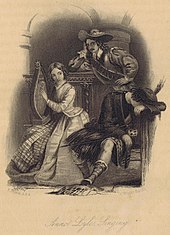
A Legend of Montrose illustration. From 1872 edition
Although Scott had attained celebrity through his poetry, he soon tried his hand at documenting his researches into the oral tradition of the Scottish Borders in prose fiction – stories and novels – at the time still considered aesthetically inferior to poetry (above all to such classical genres as the epic or poetic tragedy) as a mimetic vehicle for portraying historical events. In an innovative and astute action, he wrote and published his first novel, Waverley, anonymously. It was a tale of the Jacobite rising of 1745. Its English protagonist Edward Waverley, like Don Quixote, a great reader of romances, has been brought up by his Tory uncle, who is sympathetic to Jacobitism, although Edward's own father is a Whig. The youthful Waverley obtains a commission in the Whig army and is posted in Dundee. On leave, he meets his uncle's friend, the Jacobite Baron Bradwardine and is attracted to the Baron's daughter Rose. On a visit to the Highlands, Edward overstays his leave and is arrested and charged with desertion but is rescued by the Highland chieftain Fergus MacIvor and his mesmerizing sister Flora, whose devotion to the Stuart cause, "as it exceeded her brother's in fanaticism, excelled it also in purity". Through Flora, Waverley meets Bonnie Prince Charlie, and under her influence goes over to the Jacobite side and takes part in the Battle of Prestonpans. He escapes retribution, however, after saving the life of a Whig colonel during the battle. Waverley (whose surname name reflects his divided loyalties) eventually decides to lead a peaceful life of establishment respectability under the House of Hanover rather than live as a proscribed rebel. He chooses to marry the beautiful Rose Bradwardine, rather than cast his lot with the sublime Flora MacIvor, who, after the failure of the '45 rising, retires to a French convent.
There followed a succession of novels over the next five years, each with a Scottish historical setting. Mindful of his reputation as a poet, Scott maintained the anonymity he had begun with Waverley, publishing the novels under the name "Author of Waverley" or as "Tales of..." with no author. Among those familiar with his poetry, his identity became an open secret, but Scott persisted maintaining the façade, perhaps because he thought his old-fashioned father would disapprove of his engaging in such a trivial pursuit as novel writing. During this time Scott became known by the nickname "The Wizard of the North". In 1815 he was given the honour of dining with George, Prince Regent, who wanted to meet the "Author of Waverley".

"Edgar and Lucie at Mermaiden's well" by Charles Robert Leslie (1886), after Sir Walter Scott's Bride of Lammermoor. Lucie is wearing a full plaid.
Scott's 1819 series Tales of my Landlord is sometimes considered a subset of the Waverley novels and was intended to illustrate aspects of Scottish regional life. Among the best known is The Bride of Lammermoor, a fictionalized version of an actual incident in the history of the Dalrymple family that took place in the Lammermuir Hills in 1669. In the novel, Lucie Ashton and the nobly born but now dispossessed and impoverished Edgar Ravenswood exchange vows. But the Ravenswoods and the wealthy Ashtons, who now own the former Ravenswood lands, are enemies, and Lucie's mother forces her daughter to break her engagement to Edgar and marry the wealthy Sir Arthur Bucklaw. Lucie falls into a depression and on their wedding night stabs the bridegroom, succumbs to insanity, and dies. In 1821, French Romantic painter Eugène Delacroix painted a self-portrait of himself as the melancholy, disinherited Edgar Ravenswood. The prolonged, climatic coloratura mad scene for Lucia in Donizetti's 1835 bel canto opera Lucia di Lammermoor is based on what in the novel were just a few bland sentences.
Tales of my Landlord includes the now highly regarded novel Old Mortality set in 1679–89 against the backdrop of the ferocious anti-Covenanting campaign of the Tory aristocrat Graham of Claverhouse, Viscount of Dundee (called "Bluidy Clavers" by his opponents and Bonnie Dundee by his Tory friends). The Covenanters were religious dissenters who had risen against Charles II in protest against the reintroduction of Episcopalian church government. This had led to the destitution of around 270 ministers who had refused to take an oath of allegiance and submit themselves to bishops, and who continued to conduct worship among a remnant of their flock in caves and other remote country spots. The relentless persecution of these conventicles and attempts to break them up by military force had led to open revolt. The story is told from the point of view of Henry Morton, a moderate Presbyterian, who is unwittingly drawn into the conflict and barely escapes summary execution. In writing Old Mortality Scott drew upon the knowledge he had acquired from his researches into ballads on the subject for The Minstrelsy of the Scottish Border.[14] Scott's background as a lawyer also informed his perspective, for at the time of the novel, which takes place before the Act of Union of 1707, English law did not apply in Scotland, and even afterward Scotland continued to have its own hybrid legal system. A recent critic, who is a legal as well as a literary scholar, argues that Old Mortality not only reflects the evolution of Scottish nationalism but also invokes a foundational moment in British sovereignty, namely, the Act of Habeas corpus (also known as the Great Writ), passed by the English Parliament in 1679.[15] Oblique reference to the origin of Habeas corpus underlies Scott's next novel, Ivanhoe, set during the era of the creation of the Magna Carta, which conservatives like Walter Scott and Edmund Burke regarded as rooted in immemorial British custom and precedent.
Ivanhoe (1819) set in twelfth-century England, marked a move away from Scott's focus on the local history of Scotland. Based partly on Hume's History of England and the ballad cycle of Robin Hood, Ivanhoe was quickly translated into many languages and inspired countless imitations and theatrical adaptations. Ivanhoe depicts the cruel tyranny of the Norman overlords (Norman Yoke) over the impoverished Saxon populace of England, with two of the main characters, Rowena and Locksley (Robin Hood), representing the dispossessed Saxon aristocracy. When the protagonists are captured and imprisoned by a Norman baron, Scott interrupts the story to exclaim:
It is grievous to think that those valiant barons, to whose stand against the crown the liberties of England were indebted for their existence, should themselves have been such dreadful oppressors, and capable of excesses contrary not only to the laws of England, but to those of nature and humanity. But, alas. . . . fiction itself can hardly reach the dark reality of the horrors of the period. (Chapter 24.33)
The institution of the Magna Carta which happens outside the timeframe of the story, is portrayed as a progressive (incremental) reform, but also as a step toward recovery of a lost golden age of liberty endemic to England and the English system. Scott puts a derisive prophesy in the mouth of the jester Wamba:
Norman saw on English oak.
On English neck a Norman yoke;
Norman spoon to English dish,
And England ruled as Normans wish;
Blithe world in England never will be more,
Till England's rid of all the four. (Ivanhoe, Ch. xxvii)
Although on the surface an entertaining escapist romance, alert contemporary readers would have quickly recognized the political subtext of Ivanhoe, which appeared immediately after the English Parliament, fearful of French-style revolution in the aftermath of Waterloo, had passed the Habeas Corpus Suspension acts of 1817 and 1818 and other extremely repressive measures and when traditional English Charter rights versus revolutionary human rights was a topic of discussion.[16]
Ivanhoe was also remarkable in its sympathetic portrayal of Jewish characters: Rebecca, considered by many critics the book's real heroine, does not in the end get to marry Ivanhoe, whom she loves, but Scott allows her to remain faithful to her own religion, rather than having her convert to Christianity. Likewise, her father, Isaac of York, a Jewish moneylender, is shown as a victim rather than a villain. In Ivanhoe, as in the Waverley novels, religious and sectarian fanatics are the villains, while the eponymous hero is a bystander who must weigh the evidence and decide where to take a stand. Scott's positive portrayal of Judaism, which reflects his humanity and concern for religious toleration, also coincided with a contemporary movement for the Emancipation of the Jews in England.
[edit] Recovery of the Crown Jewels and ceremonial pageantry
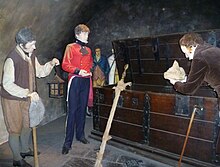
Rediscovering the 'lost' Honours of Scotland in 1818

George IV landing at Leith in 1822
Scott's fame grew as his explorations and interpretations of Scottish history and society captured popular imagination. Impressed by this, the Prince Regent (the future George IV) gave Scott permission to search for the fabled but long-lost Crown Jewels ("Honours of Scotland"), which during the years of the Protectorate under Cromwell had been squirrelled away and had last been used to crown Charles II. In 1818, Scott and a small team of military men unearthed the honours from the depths of Edinburgh Castle. A grateful Prince Regent granted Scott the title of baronet. Later, after George's accession to the throne, the city government of Edinburgh invited Scott, at the King's behest, to stage-manage the King's entry into Edinburgh.
With only three weeks for planning and execution, Scott created a spectacular and comprehensive pageant, designed not only to impress the King, but also in some way to heal the rifts that had previously destabilised Scots society. He used the event to contribute to the drawing of a line under an old world that pitched his homeland into regular bouts of bloody strife. He, along with his 'production team', mounted what in modern days could be termed a PR event, in which the (rather tubby) King was dressed in tartan (worn over pink tights), and was greeted by his people, many of whom were also dressed in similar tartan ceremonial dress. This form of dress, previously proscribed after the 1745 rebellion against the English, subsequently became one of the seminal, potent and ubiquitous symbols of Scottish identity.[17]
Much of Scott's autograph work shows an almost stream-of-consciousness approach to writing. He included little in the way of punctuation in his drafts, leaving such details to the printers to supply.[18] He eventually acknowledged in 1827 that he was the author of the Waverley novels.[17]
[edit] Financial woes and death
In 1825 and 1826, a banking crisis swept through the cities of London and Edinburgh. The Ballantyne printing business, in which he was heavily invested, crashed, resulting in his being very publicly ruined. Rather than declare himself bankrupt, or to accept any kind of financial support from his many supporters and admirers (including the King himself), he placed his house and income in a trust belonging to his creditors, and determined to write his way out of debt. He kept up his prodigious output of fiction, as well as producing a biography of Napoleon Bonaparte, until 1831. By then his health was failing. Notwithstanding this, he undertook a grand tour of Europe, being welcomed and celebrated wherever he went. He returned to Scotland and, in September 1832, died (under unexplained circumstances) at Abbotsford, the home he had designed and had built, near Melrose in the Scottish Borders. Though he died owing money, his novels continued to sell and the debts encumbering his estate were eventually discharged.[19]
[edit] His home, Abbotsford
When Scott was a boy, he sometimes travelled with his father from Selkirk to Melrose in the Border Country where some of his novels are set. At a certain spot the old gentleman would stop the carriage and take his son to a stone on the site of the Battle of Melrose (1526). Not far away was a little farm called Cartleyhole, and this Scott eventually purchased. The farmhouse developed into a wonderful home that has been likened to a fairy palace. Through windows enriched with the insignia of heraldry the sun shone on suits of armour, trophies of the chase, a library of over 9,000 volumes,[20] fine furniture, and still finer pictures. Panelling of oak and cedar and carved ceilings relieved by coats of arms in their correct colours added to the beauty of the house.
It is estimated that the building cost him over £25,000. More land was purchased until Scott owned nearly 1,000 acres (4.0 km2). A neighbouring Roman road with a ford used in olden days by the abbots of Melrose suggested the name of Abbotsford. Although Scott died at Abbotsford, he was buried in Dryburgh Abbey, where nearby there is a large statue of William Wallace, one of Scotland's many romanticised historical figures.
[edit] Legacy
[edit] Later assessment
Although he continued to be extremely popular and widely read, both at home and abroad,[21] Scott's critical reputation declined in the last half of the nineteenth century as serious writers turned from romanticism to realism, and Scott began to be regarded as an author suitable for children. This trend accelerated in the twentieth century. For example, in his classic study Aspects of the Novel (1927), E.M. Forster harshly criticized Scott's clumsy and slapdash writing style, "flat" characters, and thin plots. In contrast, the novels of Scott's contemporary Jane Austen, once appreciated only by the discerning few (including, as it happened, Sir Walter Scott himself) rose steadily in critical esteem, though Austen, as a female writer, was still faulted for her narrow ("feminine") choice of subject matter, which, unlike Scott, avoided the grand historical themes traditionally viewed as masculine.
Nevertheless, Scott's importance as an innovator continued to be recognized. He was acclaimed as the inventor of the genre of the modern historical novel and the inspiration for enormous numbers of imitators and genre writers both in Britain and on the European continent. In the cultural sphere, Scott's Waverley novels played a significant part in the movement (begun with James Macpherson's Ossian cycle) in rehabilitating the public perception of the culture of the Scottish Highlands and its culture, which had been formally suppressed as barbaric –and viewed in the southern mind as a breeding ground of hill bandits, religious fanaticsim, and Jacobite rebellions. Scott served as chairman of the Royal Society of Edinburgh and was also a member of the Royal Celtic Society. His own contribution to the reinvention of Scottish culture was enormous, even though his re-creations of the customs of the Highlands were fanciful at times, his extensive travels around his native country, notwithstanding. It is a testament to Scott's contribution in creating a unified identity for Scotland that Edinburgh's central railway station, opened in 1854 by the North British Railway, is called Waverley. The fact that Scott was a Lowland Episcopalian, rather than a Gaelic-speaking Catholic Highlander or Presbyterian, made him more acceptable to a conservative English reading public. Scott's novels were certainly influential in the making of the Victorian craze for all things Scottish among British royalty, who were anxious to claim legitimacy through their rather attenuated historical connection with the royal house of Stuart.
At the time Scott wrote, Scotland was poised to move away from an era of socially divisive clan warfare to a modern world of literacy and industrial capitalism. Through the medium of Scott's novels, the violent religious and political conflicts of the country's recent past could be seen as belonging to history – which Scott defined, as the subtitle of Waverley ("'Tis Sixty Years Hence") indicates, as something that happened at least 60 years ago. Scott's advocacy of objectivity and moderation and his strong repudiation of political violence on either side also had a strong, though unspoken contemporary resonance in an era when many conservative English speakers lived in mortal fear of a revolution in the French style on British soil. Scott's orchestration of King George IV's visit to Scotland, in 1822 was a pivotal event intended to inspire a view of his home country that, in his view, accentuated the positive aspects of the past while allowing the age of quasi-mediaeval blood-letting to be put to rest and the envisioning of a more useful, hopefully peaceful future.
After being essentially unstudied for many decades, a small revival of critical interest in Scott's work began in the 1970s and 1980s. Postmodern tastes favoured discontinuous narratives and the introduction of the 'first person', yet they were more favourable to Scott's work than Modernist tastes. F. R. Leavis had rubbished Scott, seeing him as a thoroughly bad novelist and a thoroughly bad influence (The Great Tradition [1948]); Marilyn Butler, however, offered a political reading of the fiction of the period that found a great deal of genuine interest in his work (Romantics, Revolutionaries, and Reactionaries [1981]). Scott is now seen as an important innovator and a key figure in the development of Scottish and world literature.[22]
[edit] Memorials and commemoration

The Scott Monument on Edinburgh's Princes Street
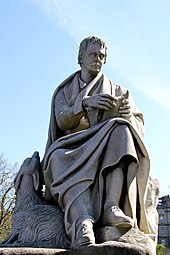
Statue by Sir John Steell on the Scott Monument in Edinburgh
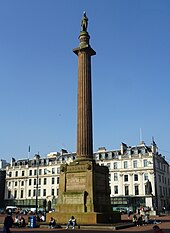
Scott Monument in Glasgow's George Square

Statue on the Glasgow monument

Walter Scott's stone slab at the Makars' Court outside The Writers' Museum in Edinburgh
During his lifetime, Scott's portrait was painted by Sir Edwin Landseer and fellow-Scots Sir Henry Raeburn and James Eckford Lauder. In Edinburgh, the 61.1 metre tall Victorian Gothic spire of the Scott Monument was designed by George Meikle Kemp. It was completed in 1844, 12 years after Scott's death, and dominates the south side of Princes Street. Scott is also commemorated on a stone slab in Makars' Court, outside The Writers' Museum, Lawnmarket, Edinburgh, along with other prominent Scottish writers; quotes from his work are also visible on the Canongate Wall of the Scottish Parliament building in Holyrood. There is a tower dedicated to his memory on Corstorphine Hill in the west of the city and as mentioned previous Edinburgh's Waverley railway station takes the name of one of his novels.
In Glasgow, Walter Scott's Monument dominates the centre of George Square, the main public square in the city. Designed by David Rhind in 1838, the monument features a large column topped by